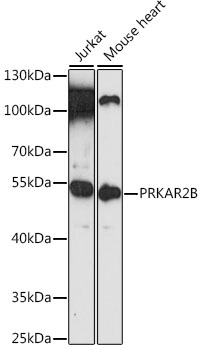Cell Biology Antibodies 3
Anti-PRKAR2B Antibody (CAB12751)
- SKU:
- CAB12751
- Product Type:
- Antibody
- Reactivity:
- Human
- Reactivity:
- Mouse
- Host Species:
- Rabbit
- Isotype:
- IgG
- Antibody Type:
- Polyclonal Antibody
- Research Area:
- Cell Biology
Description
| Antibody Name: | Anti-PRKAR2B Antibody |
| Antibody SKU: | CAB12751 |
| Antibody Size: | 20uL, 50uL, 100uL |
| Application: | WB |
| Reactivity: | Human, Mouse |
| Host Species: | Rabbit |
| Immunogen: | Recombinant fusion protein containing a sequence corresponding to amino acids 1-100 of human PRKAR2B (NP_002727.2). |
| Application: | WB |
| Recommended Dilution: | WB 1:500 - 1:2000 |
| Reactivity: | Human, Mouse |
| Positive Samples: | Jurkat, Mouse heart |
| Immunogen: | Recombinant fusion protein containing a sequence corresponding to amino acids 1-100 of human PRKAR2B (NP_002727.2). |
| Purification Method: | Affinity purification |
| Storage Buffer: | Store at -20'C. Avoid freeze / thaw cycles. Buffer: PBS with 0.02% sodium azide, 50% glycerol, pH7.3. |
| Isotype: | IgG |
| Sequence: | MSIE IPAG LTEL LQGF TVEV LRHQ PADL LEFA LQHF TRLQ QENE RKGT ARFG HEGR TWGD LGAA AGGG TPSK GVNF AEEP MQSD SEDG EEEE AAPA DAGA |
| Gene ID: | 5577 |
| Uniprot: | P31323 |
| Cellular Location: | Cell membrane, Cytoplasm |
| Calculated MW: | 46kDa |
| Observed MW: | 50kDa |
| Synonyms: | PRKAR2B, PRKAR2, RII-BETA |
| Background: | cAMP is a signaling molecule important for a variety of cellular functions. cAMP exerts its effects by activating the cAMP-dependent protein kinase, which transduces the signal through phosphorylation of different target proteins. The inactive kinase holoenzyme is a tetramer composed of two regulatory and two catalytic subunits. cAMP causes the dissociation of the inactive holoenzyme into a dimer of regulatory subunits bound to four cAMP and two free monomeric catalytic subunits. Four different regulatory subunits and three catalytic subunits have been identified in humans. The protein encoded by this gene is one of the regulatory subunits. This subunit can be phosphorylated by the activated catalytic subunit. This subunit has been shown to interact with and suppress the transcriptional activity of the cAMP responsive element binding protein 1 (CREB1) in activated T cells. Knockout studies in mice suggest that this subunit may play an important role in regulating energy balance and adiposity. The studies also suggest that this subunit may mediate the gene induction and cataleptic behavior induced by haloperidol. |
| UniProt Protein Function: | PKAR2B: a regulatory subunit of cAMP-regulated protein kinase. The inactive form of the enzyme is composed of two regulatory chains and two catalytic chains. Activation by cAMP produces two active catalytic monomers and a regulatory dimer that binds four cAMP molecules. Four types of regulatory chains are found: I-alpha, I-beta, II-alpha, and II-beta. Their expression varies among tissues and is in some cases constitutive and in others inducible. Type II regulatory chains mediate membrane association by binding to anchoring proteins, including the MAP2 kinase. |
| UniProt Protein Details: | Protein type:Mitochondrial; Protein kinase, regulatory subunit Chromosomal Location of Human Ortholog: 7q22.3 Cellular Component: centrosome; cytoplasm; cytosol; dendritic shaft; dendritic spine; plasma membrane Molecular Function:cAMP-dependent protein kinase inhibitor activity; cAMP-dependent protein kinase regulator activity; protein binding; ubiquitin protein ligase binding Biological Process: activation of protein kinase A; blood coagulation; G2/M transition of mitotic cell cycle; renal water homeostasis |
| NCBI Summary: | cAMP is a signaling molecule important for a variety of cellular functions. cAMP exerts its effects by activating the cAMP-dependent protein kinase, which transduces the signal through phosphorylation of different target proteins. The inactive kinase holoenzyme is a tetramer composed of two regulatory and two catalytic subunits. cAMP causes the dissociation of the inactive holoenzyme into a dimer of regulatory subunits bound to four cAMP and two free monomeric catalytic subunits. Four different regulatory subunits and three catalytic subunits have been identified in humans. The protein encoded by this gene is one of the regulatory subunits. This subunit can be phosphorylated by the activated catalytic subunit. This subunit has been shown to interact with and suppress the transcriptional activity of the cAMP responsive element binding protein 1 (CREB1) in activated T cells. Knockout studies in mice suggest that this subunit may play an important role in regulating energy balance and adiposity. The studies also suggest that this subunit may mediate the gene induction and cataleptic behavior induced by haloperidol. [provided by RefSeq, Jul 2008] |
| UniProt Code: | P31323 |
| NCBI GenInfo Identifier: | 206729918 |
| NCBI Gene ID: | 5577 |
| NCBI Accession: | P31323.3 |
| UniProt Secondary Accession: | P31323,A4D0R9, |
| UniProt Related Accession: | P31323 |
| Molecular Weight: | 46kDa |
| NCBI Full Name: | cAMP-dependent protein kinase type II-beta regulatory subunit |
| NCBI Synonym Full Names: | protein kinase cAMP-dependent type II regulatory subunit beta |
| NCBI Official Symbol: | PRKAR2B |
| NCBI Official Synonym Symbols: | PRKAR2; RII-BETA |
| NCBI Protein Information: | cAMP-dependent protein kinase type II-beta regulatory subunit |
| UniProt Protein Name: | cAMP-dependent protein kinase type II-beta regulatory subunit |
| Protein Family: | cAMP-dependent protein kinase |
| UniProt Gene Name: | PRKAR2B |
View AllClose







